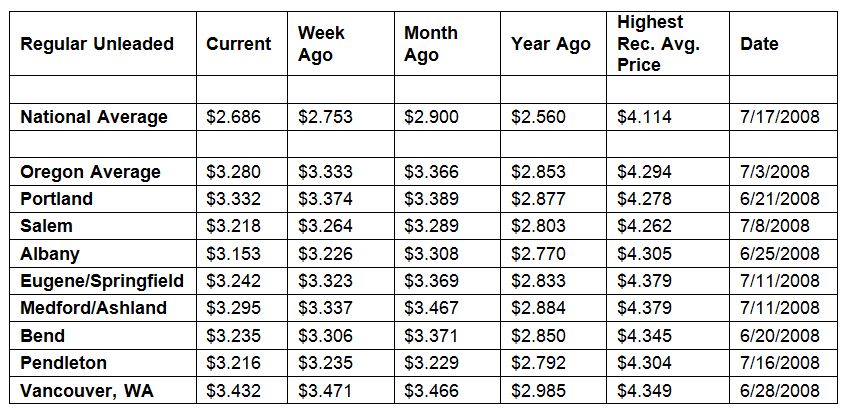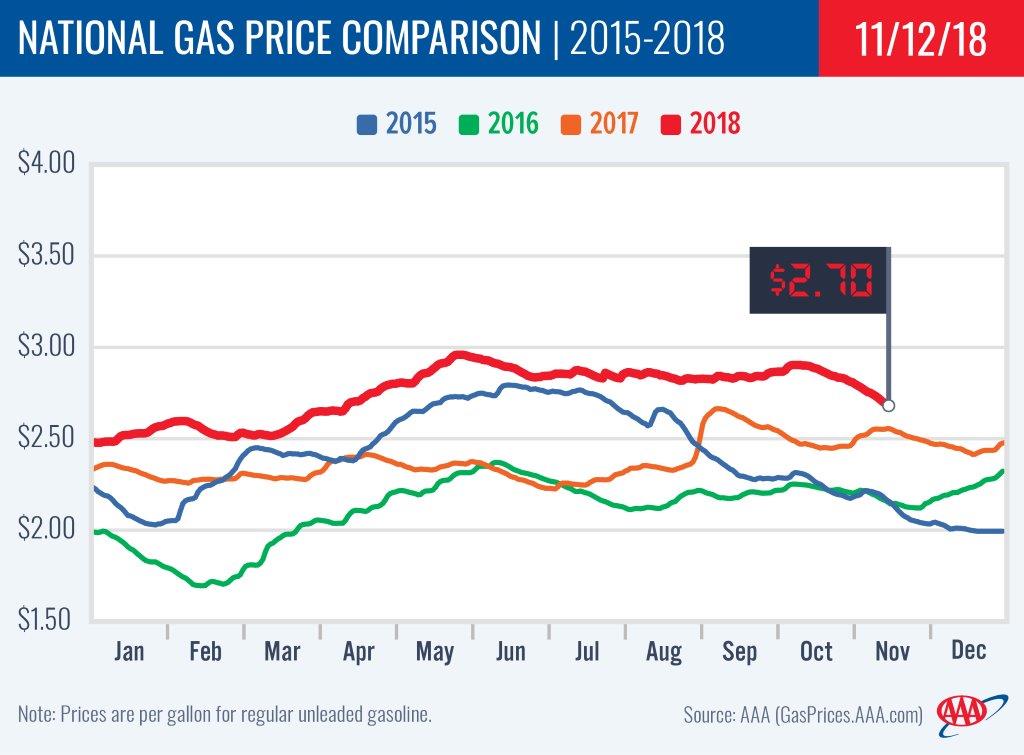PORTLAND, Ore., – Falling crude oil prices and the reduced demand for gasoline typically seen this time of year are sending pump prices lower in all 50 states. For the week, the national average for regular loses six cents to $2.81 while Oregon’s average falls a nickel to $3.28.
Pump prices could fall even more, especially if we see a surge in gasoline production after refinery maintenance season wraps up,” says Marie Dodds, public affairs director for AAA Oregon/Idaho. “Another factor driving down fuel prices is the drop in crude oil prices. U.S. crude has dipped below $60 per barrel, its lowest price since last December.”
Gas Prices are lower week-over-week in all 50 states and the District of Colombia. Ohio has the largest weekly decrease (-12 cents). Arizona has the smallest weekly decrease (-1 cent). This week seven states have averages at or above $3 a gallon, down from eight a week ago.
Pump prices are lower than a month ago in every state except Hawaii. The national average is 21 cents less and the Oregon average is nine cents less than a month ago. Delaware has the largest monthly decrease (-35 cents). Hawaii is the only state with a monthly increase (+1 cent). Prices on the West Coast spiked last month after a natural gas pipeline rupture in British Columbia, Canada. This forced three Puget Sound refineries to shut production units and impacted gas prices in the region.
The West Coast continues to have the most expensive gas prices in the nation. Hawaii tops the list for the 23rd week in a row with California, Washington, Alaska, Oregon, Nevada and Idaho rounding out the top seven. Oregon is fifth for the fourth week in a row. On the week, California and Oregon saw the largest drops at a nickel each.
| Rank | Region | Price on 11/13/18 | |
| 1 | Hawaii | $3.90 | |
| 2 | California | $3.70 | |
| 3 | Washington | $3.47 | |
| 4 | Alaska | $3.34 | |
| 5 | Oregon | $3.28 | |
| 6 | Nevada | $3.25 | |
| 7 | Idaho | $3.07 | |
| 8 | Utah | $2.98 | |
| 9 | Montana | $2.94 | |
| 10 | Connecticut | $2.92 |
The U.S. Energy Information Administration’s (EIA) weekly petroleum status report for the week ending on November 2, showed West Coast gasoline stocks grew to 27.3 million bbl. Stocks are approximately 200,000 bbl lower than at this time last year, which could cause prices to spike if there is a supply challenge in the region this week.
The nation’s cheapest markets are Delaware ($2.34) and Missouri ($2.36). For the 67th week in a row, no states have an average below $2.
Drivers in 44 states and the District of Columbia are paying more than a year ago to fill up. The national average is 13 cents more and the Oregon average is 43 cents more than a year ago. This is the seventh-largest yearly increase in the country. Hawaii (+68 cents) has the greatest year-over-year increase; Nevada (+51 cents) is second; Utah (+51 cents) is third; Arizona (+49 cents) is fourth; and Washington (+47 cents) is fifth.
Oil Market Dynamics
Crude oil prices continue to skid, falling to their lowest prices since last December, due to rising supplies and an easing of U.S. oil sanctions on Iran that included waivers for major crude importers including China. Crude prices drifted lower this week following the release of EIA’s report that total domestic oil inventories grew by 5.8 million bbl last week. They now sit at 431.8 million bbl, which is 25.3 million bbl less than inventories last year at this time. Crude inventories have grown for seven consecutive weeks because of reduced refinery runs while the nation settles into the lower demand fall driving season.
A new all-time high estimate in domestic crude production since EIA began publishing the data – 11.6 million b/d – also contributed to last week’s build in crude inventories.
At the close of Friday’s formal trading session on the NYMEX, WTI decreased 48 cents to settle at $60.19. At the close of Monday’s formal trading session on the NYMEX, WTI lost 26 cents to settle at $59.93. Today crude is trading around $56, compared to $62 a week ago. Crude prices are down about 20 percent in the last month and are about $3 more per barrel than a year ago.
Drivers can find current gas prices along their route with the free AAA Mobile app for iPhone, iPad and Android. The app can also be used to map a route, find discounts, book a hotel and access AAA roadside assistance. Learn more at AAA.com/mobile.
Diesel
For the week, the national average falls two cents to $3.25 a gallon. Oregon’s average also dips two cents to $3.43. A year ago the national average for diesel was $2.83 and the Oregon average was $3.00.
Find current fuel prices at GasPrices.AAA.com.
AAA news releases, high resolution images, broadcast-quality video, fact sheets and podcasts are available on the AAA NewsRoom at NewsRoom.AAA.com.



